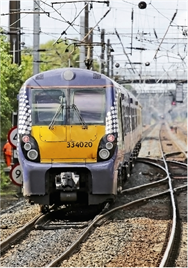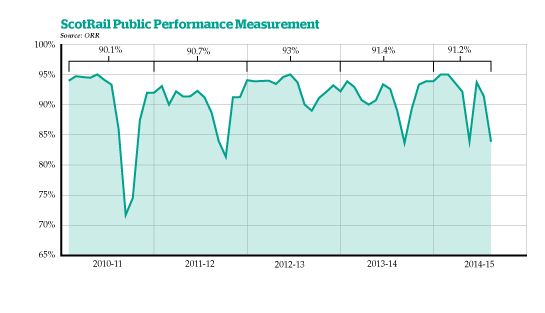 Download the graphs for this feature.
Download the graphs for this feature.
The prospect for Scotland is very different, so it is worth examining how substantive improvements have been enshrined in the new ScotRail and Sleeper franchises.
The franchising process has been managed by Transport Scotland Commercial Director Bill Reeve. “It may sound as though one is stating the obvious, but if you are about to let the Scottish Government’s largest contract at £3 billion-plus over ten years, it is important to have absolute clarity about the objectives and how they can be brought to fruition,” he says.
The Scottish Government’s stated purpose is to promote sustainable economic growth for people throughout Scotland, a purpose for which rail is well placed to contribute.
With the ScotRail franchise due for renewal in 2015, Reeve was put in charge of a small commercial unit. An early decision was to take the Caledonian Sleeper out of the ScotRail franchise, and allow a new franchisee to focus solely on customer needs, marketing and operation of that distinctive service.
Two immediate tasks were set. The first was to create a team dedicated to rail franchise procurement, which most would see as the biggest single determinant of the railway’s future.
Since Transport Scotland is largely a procurement organisation - buying bridges, ferries, roads and even airfields - it has developed substantial expertise in the process. But a sound understanding of the principles of procurement law needs to be matched by, as Reeve neatly puts it: “a team that knows its brake sticks from its shunting poles”.
Second was the need to gain a clear understanding of what the public and stakeholders wanted the railway in Scotland to be. A Rail 2014 consultation was conducted over three months in 2011-12, and elicited more than 1,400 responses. As well as events at stations from Stranraer to Inverness, more than 30 meetings were held with stakeholders such as the CBI, the Scottish Council for Development and Industry, Chambers of Commerce, passenger groups, Regional Transport Partnership areas and accessibility groups.
Reeve recalls: “We even asked basic questions such as: did they want the Sleeper to even continue? It was rather reassuring that most deemed it deeply offensive that we had even asked the question.
“Three priorities came out of the consultation: speed and comfort; integrated transport services and ticketing; and engagement with communities. The exercise gave us confidence that we had the strong underwriting of the people of Scotland and from the body politic about their expectations for the railway and steady improvements in quality.”
With a balanced team in place and having gained an insight into the public’s aspirations for rail, Reeve’s team worked through a series of iterations with Transport Scotland’s Rail Policy team to “devise a procurement policy informed by what was practical and possible to achieve”.
He adds: “Our approach has been to encourage a challenging response where we wanted things to change, but not so challenging that it is undeliverable and unreasonable. Working out that balance requires a measure of expertise.”
Naturally that balance needed to take account of the competitive environment in Scotland, which is very different from England and Wales. The good road network and comparatively low levels of congestion in Scotland give people a real modal choice, so the railways have to be attractive to win passengers. The challenge is made greater by the Scottish Government’s fares policy - regulated fares on peak services can increase by no more than RPI and off-peak by RPI-1%.
Although the Brown Review of the rail franchising programme and the Laidlaw Inquiry in the wake of the West Coast franchise debacle had yet to appear, Reeve had anticipated their conclusions by ensuring that Transport Scotland was a competent, expertly informed client. The commercial unit team could draw on outside technical support from Atkins, financial advice from Ernst & Young, and legal input from DWF Biggart Baillie.
 The next requirement was clarity. Reeve believes that some of the eternal verities of railway economics have been lost in recent decades - one being that the very high fixed-cost nature of railways can be amortised only by maximising returns, yet some rail industry arrangements fail to incentivise growth.
The next requirement was clarity. Reeve believes that some of the eternal verities of railway economics have been lost in recent decades - one being that the very high fixed-cost nature of railways can be amortised only by maximising returns, yet some rail industry arrangements fail to incentivise growth.











